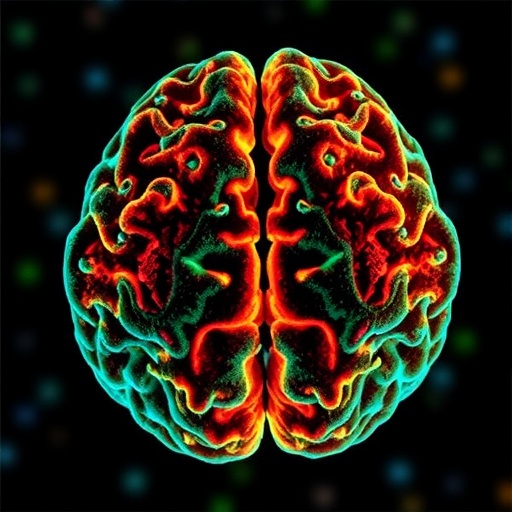In a groundbreaking study published recently in Translational Psychiatry, researchers have unveiled a profound link between TAAR1 deficiency and the disruption of mitochondrial dynamics and synaptic integrity within the medial prefrontal cortex (mPFC) of mice. This revelation sheds light on the molecular underpinnings of cognitive deficits related to this brain region, offering a novel perspective on the intricate mechanisms governing cognition and neural connectivity. The findings underscore the critical role of the trace amine-associated receptor 1 (TAAR1), a G protein-coupled receptor, in maintaining cellular and synaptic homeostasis that ultimately dictates cognitive function.
The medial prefrontal cortex is renowned for its pivotal involvement in high-order cognitive tasks such as decision-making, working memory, and social behavior. Dysfunction within this brain area often correlates strongly with neuropsychiatric disorders, including schizophrenia, depression, and autism spectrum disorder. Despite its importance, the molecular pathways contributing to mPFC integrity have remained elusive until now. The current study meticulously elucidates how TAAR1 deficiency compromises mitochondrial dynamics—specifically the balance between mitochondrial fusion and fission processes vital to energy production and cellular resilience.
Central to this investigation was the deployment of TAAR1 knockout mice, providing an instrumental model to parse out the receptor’s physiological duties. The researchers employed advanced microscopy techniques paired with biochemical assays to monitor mitochondrial morphology and function within mPFC neurons. They observed that the absence of TAAR1 skewed mitochondrial morphology toward fragmentation—a hallmark of impaired mitochondrial dynamics—resulting in attenuated mitochondrial respiration and elevated oxidative stress markers. This mitochondrial mismanagement directly impinges on neuronal health, as neurons rely heavily on efficient mitochondrial function to sustain synaptic activity.
Synapses, the specialized junctions enabling neuronal communication, exhibited significant structural and functional deterioration in TAAR1-deficient mice. Detailed electron microscopy revealed a marked reduction in synaptic density and disturbed synaptic vesicle distribution, suggesting that the synaptic architecture’s integrity is compromised in the absence of TAAR1 signaling. This synaptic fragility is critical because synapses serve as the fundamental units for information processing and plasticity in the brain. Hence, any disruption herein precipitates significant cognitive and behavioral deficits.
Corroborating these cellular insights, behavioral analyses painted a concordant picture. TAAR1 knockout mice displayed pronounced deficits in tasks reliant on mPFC-dependent cognition, including impaired working memory and disrupted cognitive flexibility. These functional impairments mirror those seen in certain human psychiatric conditions, providing a plausible translational model for studying the neuropathology of cognitive disorders. The data imply that TAAR1’s modulation of mitochondrial and synaptic physiology is indispensable for sustaining optimal cognitive processes.
What sets this study apart is its detailed dissection of the molecular cascade linking TAAR1 deficiency to mitochondrial and synaptic dysfunction. The loss of TAAR1 appears to perturb the signaling pathways that regulate key mitochondrial dynamics proteins such as mitofusins and dynamin-related protein 1 (Drp1). Such dysregulation promotes excessive mitochondrial fission, culminating in energy deficits and propensity to neuronal damage. Moreover, this mitochondrial vulnerability cascades into synaptic failure, likely through decreased ATP availability and increased reactive oxygen species (ROS), which are detrimental to synaptic vesicle cyclic turnover and neurotransmission fidelity.
Further highlighting the therapeutic relevance, the authors propose that TAAR1 agonists—currently under investigation for a variety of neuropsychiatric applications—may restore mitochondrial health and synaptic integrity. This therapeutic avenue holds immense promise, as it targets putative upstream defects rather than just symptomatic consequences. Pharmacological activation of TAAR1 could reinstate mitochondrial dynamics equilibrium, bolster synaptic robustness, and ultimately rehabilitate cognitive function impaired by receptor deficiency or dysfunction.
The study also integrates transcriptomic analyses that reveal altered gene expression profiles in the mPFC of TAAR1 knockout mice, emphasizing how receptor loss orchestrates widespread molecular remodeling within neural circuits. Genes implicated in mitochondrial biogenesis, oxidative stress response, and synaptic plasticity were notably dysregulated, furnishing a comprehensive picture of the molecular perturbations underpinning the observed cellular phenotypes. Such multilevel interrogation—from molecular signaling to behavior—exemplifies an integrative approach that enriches our understanding of brain function.
Intriguingly, TAAR1’s role extends beyond mitochondrial and synaptic physiology, intersecting with neuroimmune pathways that influence neuroinflammation—a factor increasingly recognized as influential in cognitive decline. The authors speculate that TAAR1 deficiency may exacerbate microglial activation states, further compromising neural environment homeostasis. This interplay between mitochondrial malfunction and neuroinflammation could amplify pathological cascades leading to progressive cognitive deterioration.
From a broader neuroscience perspective, the implications of these findings are profound. They provide compelling evidence that TAAR1 serves as a molecular nexus bridging energy metabolism and synaptic efficacy, a tandem crucial for cognitive integrity. The insights could recalibrate current conceptual frameworks about neuropsychiatric disease pathogenesis and inspire novel biomarker identification approaches that leverage mitochondrial and synaptic dysfunction signals.
The study’s methodology also stands as a testament to cutting-edge neurobiological research. Employing state-of-the-art imaging, electrophysiological recordings, and behavioral paradigms, along with sophisticated molecular analyses, the researchers created a robust multidimensional dataset that rigorously supports their conclusions. This scientific rigor amplifies confidence in the reproducibility and applicability of their findings to related research contexts and potential clinical translation.
Looking ahead, this research opens new investigative corridors. Future studies might explore whether TAAR1 modulation protects against cognitive decline in aging or neurodegenerative conditions characterized by mitochondrial impairment. Furthermore, understanding how TAAR1 interacts with other neurotransmitter systems and signaling pathways might reveal synergistic mechanisms governing neuronal resilience and plasticity.
In summation, the revelation that TAAR1 deficiency disrupts mitochondrial dynamics and synaptic integrity in the mPFC offers a transformative lens for examining cognitive dysfunction’s molecular roots. This landmark study not only delineates critical cellular dysfunctions but also kindles hope for innovative treatments targeting receptor pathways to restore cognitive health. Through this work, the scientific community edges closer to unraveling the complex cellular symphony underlying thought, memory, and behavior—ushering in an era of precision neuropsychiatry.
Article References:
Zhang, XQ., Xiong, J., Liu, DN. et al. TAAR1 deficiency impairs mitochondrial dynamics and synaptic integrity in the medial prefrontal cortex and associated cognition in mice. Transl Psychiatry 15, 490 (2025). https://doi.org/10.1038/s41398-025-03727-3
Image Credits: AI Generated
DOI: 21 November 2025




